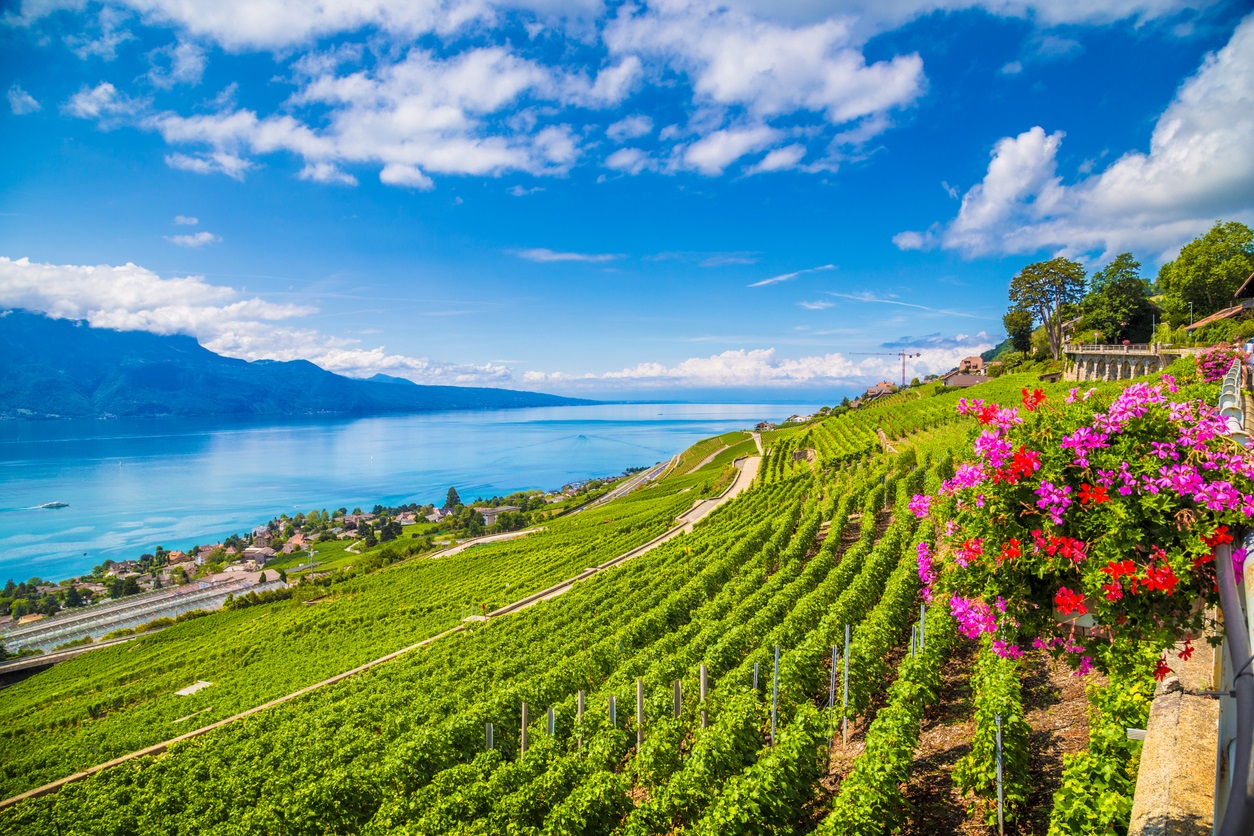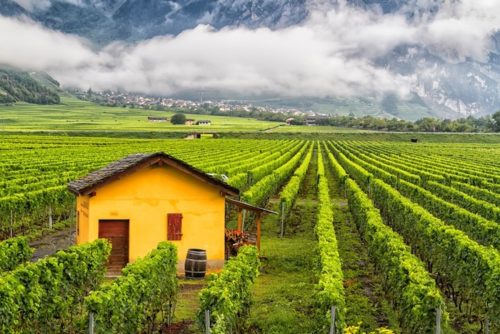Swiss Wine & Swiss Wine Region Guide
Most of us imagine the country of Switzerland as having beautiful landscapes, quaint villages, and picturesque views of the Swiss Alps. But did you know that the wine coming out of Switzerland is remarkably tasteful, complex, and worth exploring? In fact, one particular Swiss wine region — known as Lavaux — is a UNESCO-protected stretch of land that spans over 30 kilometers along the Northern banks of Lake Geneva.
RELATED: Lavaux Wine Tasting: Visit the Terraced Vineyards & Best Wineries
The vineyard terraces themselves are some of the most special in the world, beset beneath a truly epic landscape and terroir where people, land, and culture come together to depict thousands of years of a working relationship resulting in beautiful wine. Wine production practices throughout Switzerland can be traced as far back as ancient Rome.
- Swiss Wine & Swiss Wine Region Guide
- Why Haven't I Had Swiss Wine Before?
- Visiting and Trying the Wines of Switzerland
- Dominant Swiss Wines & Grape Varieties Produced in Switzerland
- Swiss Wine Grape Varieties of Special Significance
- The Main Wine Regions of Switzerland
- Frequently Asked Questions about Swiss Wine & Swiss Wine Regions
Why Haven’t I Had Swiss Wine Before?
The wines of Switzerland have flown mostly under the radar, in large part due to the fact that you can’t find them in most domestic US markets. Both red and white wines are produced, with acreage split between white (42%) and red wines (58%). In fact, only a mere 2% of the wine produced within Switzerland’s borders is exported — to Germany.
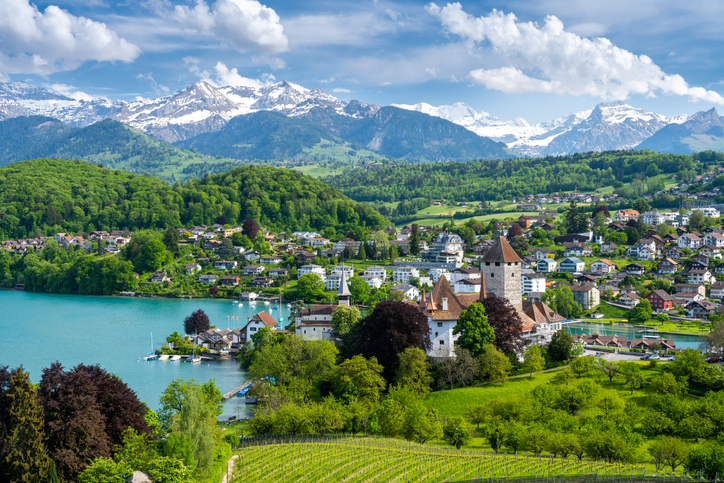
Visiting and Trying the Wines of Switzerland
Despite Swiss wine country’s relative obscurity, accessing these beautiful landscapes filled with grapevines and epic mountain peaks is relatively easy to achieve. This is especially true of Lavaux within Geneva — and Valais (both of which we discuss in more detail further on in this guide). Two of the most noteworthy wine-growing regions in the country.
If you want to visit, the most cost-effective thing you can do is browse and compare flight deals on Kayak and attempt to book early. Once in country, simply hop on a train from the international hubs and Swiss towns of Zurich or Geneva and you can be at St. Saphorin train station in Vaud within about one hour. Head a little further southeast and you can be within the southern Swiss wine region of Valais in just a couple of hours.
RECOMMENDED: Take a Private Day Tour to Grindelwald, Lauterbrunnen, Interlaken & Mürren from Zurich
Alternatively, you can rent a car, which is our favorite way to explore Switzerland. There’s nothing quite like driving at a leisurely place through some of the most stunningly scenic countryside and quaint villages in the world. Check current prices on car rentals right here. See some of our favorite Swiss hotels on TripAdvisor.
RELATED: The Most Beautiful Swiss Mountain Villages to Visit This Year
Dominant Swiss Wines & Grape Varieties Produced in Switzerland
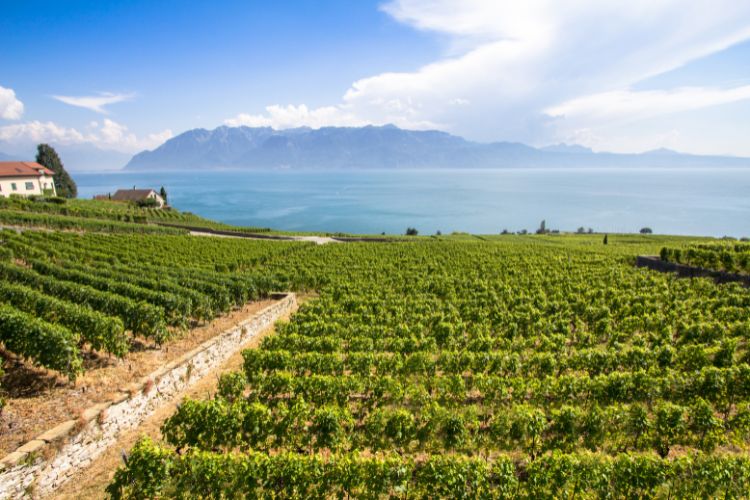
Roughly 20 or so grape varieties are produced within Switzerland’s borders. Not surprisingly, one international favorite, Pinot Noir, does exceedingly well throughout the cooler, elevated cantons of Swiss wine country.
Top Swiss Red Wine
Pinot Noir (Blauburgunder)
Pinot Noir (called Blauburgunder in Switzerland), accounts for almost 30% of all grape production in the country. In fact, one small German-speaking appellation called Bündner Herrschaft, within the famed canton of Graubünden is world-famous for producing small-lot, artisanal style Pinot Noir.
Despite Bündner Herrschaft being one of the warmer Swiss wine regions, breezes dubbed the Föhn wind come down from the nearby mountain range and help maintain a consistent climate conducive to producing fine Blauburgunder wines. In fact, these wines are of such great quality that they are some of the few Pinot’s in the world that are suitable to relatively long-term aging in oak casks. Pinot Noir here really is some of the most prized in the world, even though many aren’t even aware of their quality. You’ll just have to visit for a taste!
Top Swiss White Wine
Chasselas (Gutedel)
Following in close second is the Chasselas grape variety (called Gutedel in Switzerland), which produces a light-bodied, crisp white wine that accounts for about 27% of grape production. Smaller concentrations of over 18 other grapes are also grown, including some rare varieties you can’t find anywhere else within just a few dozen acres. Below, you’ll find a list of international and Swiss wine grape varieties by order of production volume from largest to smallest.
List of Swiss Wines & Grapes
- Pinot Noir
- Chasselas
- Gamay
- Merlot
- Müller-Thurgau
- Gamaret
- Chardonnay
- Sylvaner
- Pinot Gris
- Garanoir
- Syrah
- Petite Arvine
- Amigne
- Sauvignon Blanc
- Humagne Rouge
- Humagne Blanche
- Cornalin
- Diolinoir
- Pinot Blanc
- Savagnin Blanc
- Cabernet Sauvignon
- Cabernet Franc
- Reze
Swiss Wine Grape Varieties of Special Significance
Petite Arvine
Arguably one of the most unique and premium quality white wines coming out of Switzerland is the Petite Arvine variety. Entire villages are in some cases dedicated to its production within the beautiful region of Valais. These wines can be crafted in dry, off-dry or even sweet styles, though I believe their best expression shines through as dry wines where their citrus, tree fruit, and mineral tones become more detectable.
Petite Arvine-based wines typically maintain low acidity and little to no astringency despite their thick skins aiding in producing medium to full-bodied, flavor-packed wines. This is a refreshing variety that must be sampled when visiting Valais. No words can do the complexity and craftwork justice, you’ll need your palate to express it for you.
Amigne
Another special grape variety produced exclusively within Switzerland is the Amigne variety. This is a full-bodied, relatively low acid white wine that can be made in a range of styles — from dry to sweet. Roughly 110 acres of vineyard plantings exist, primarily within Vétroz in Valais. It’s a somewhat unique variety from a flavor perspective, in that it encompasses your classic citrus and stone-fruit white wine flavors, but it has some hints of almond bread and herbal characteristics as well.
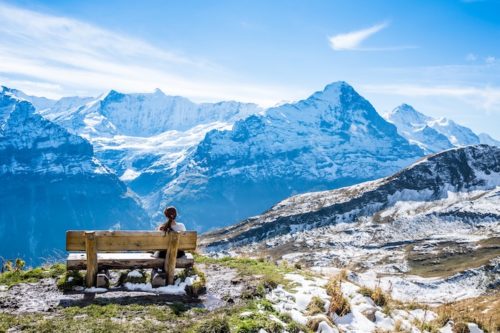
The Main Wine Regions of Switzerland
Geneva
I think what strikes me the most about the Swiss wine region of Geneva is the contrast between the rural and the urban. Just a few miles from one of the more pristine cities in the world are acres of grapevines beset beneath rolling hills and quiet winds. Within the Geneva countryside also resides one of Switzerland’s largest wine-producing villages, Satigny.
There are a number of ways to explore the Geneva countryside, and both the right and left banks of the Rhône river offer wine enthusiasts and professionals an opportunity to taste different terroirs. You’ll have three somewhat clear-cut regions to explore. One of them is the Rive Droit — considered the “right bank” or western side of Lake Geneva and encompasses the village of Satigny. Entre Arve et Lac — otherwise known as the “left bank” of the lake, is east and between the Arve river. Lastly, Entre Arve et Rhone – encompasses a relatively small portion of land that is wedged between both the Rhône and Arve Rivers.
Worth noting here is that the canton of Geneva should not be confused with the northern shoreline of Lake Geneva, which is typically analogous to the canton of Vaud (Lavaux, in particular).
Given Geneva’s proximity to France, a number of grape varieties can be found throughout the region. Recently, fine Sauvignon Blanc, Chasselas and even Viognier are being produced. Other varieties of non-Swiss origin are also planted, including Malbec, Cabernet Sauvignon, Riesling, and Gamay.
RELATED: Here’s How Travel Will Make You Smarter
Neuchâtel
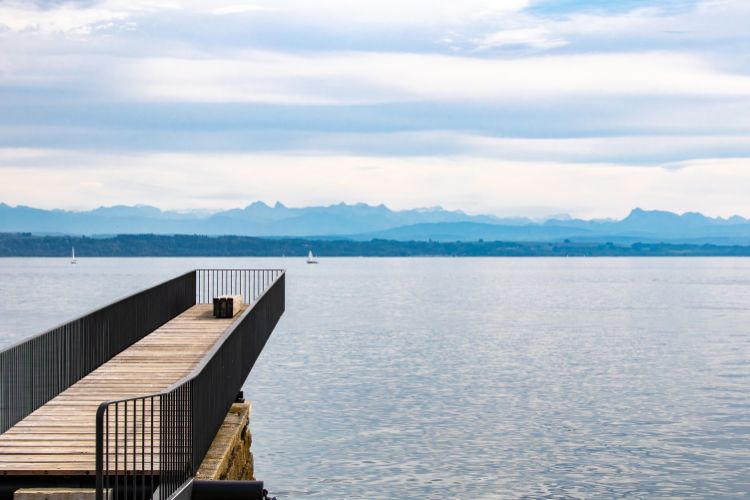

Located in northwestern Switzerland along Lac de Neuchâtel, the canton of Neuchâtel itself is undoubtedly best known for the production of its Oeil-de-Perdix Rosé, a soft-toned rosé crafted from the Pinot Noir grape variety that has been produced in the region for centuries. In addition to Oeil-de-Perdix (keep in mind this name has also been stolen from other regions around the world due to the failure of Neuchâtel from protecting it), both Chasselas and Pinot Noir are also produced in earnest throughout the canton.
There is also an annual grape harvest that essentially shuts down traffic throughout the city. Dubbed Fête des Vendanges — which begins in October — this colorful festival lasts for three days with festival-goers eating, drinking, and dressing up in a variety of costumes.
RELATED: 10 Picturesque Wine Regions for Photography Enthusiasts
Graubünden
Graubünden is a Swiss canton within the eastern reaches of Switzerland. It is almost exclusively German-speaking and spans the Rhine Valley near the border of Austria. While this region has been producing fine wine since antiquity, it wasn’t until about the 17th century that Pinot Noir began to emerge as the premier grape variety within the canton of Graubünden, especially that which is produced within the smaller appellation of Bündner Herrschaft. In addition to Pinot Noir, Humagne Rouge is also produced in smaller artisanal styles and batches of superb quality.
While Swiss red wine remains the favorite here, white wines are crafted in smaller quantities and include Chardonnay, Sauvignon Blanc, Pinot Blanc, and Pinot Gris.
Depending on the style of wine being produced, Graubünden offers vintners an opportunity to milk the fruits of the land. Whether it’s utilizing elevation and poorer quality soil along the Rätikon Alps, or leveraging the more fertile soil on the valley floor. Wines crafted from vineyard sites that are at elevation and utilize terraced, well-drained, poor quality soil tends to make the grape vines work harder. Thus, yielding more complexity in the final wine product.
Ticino
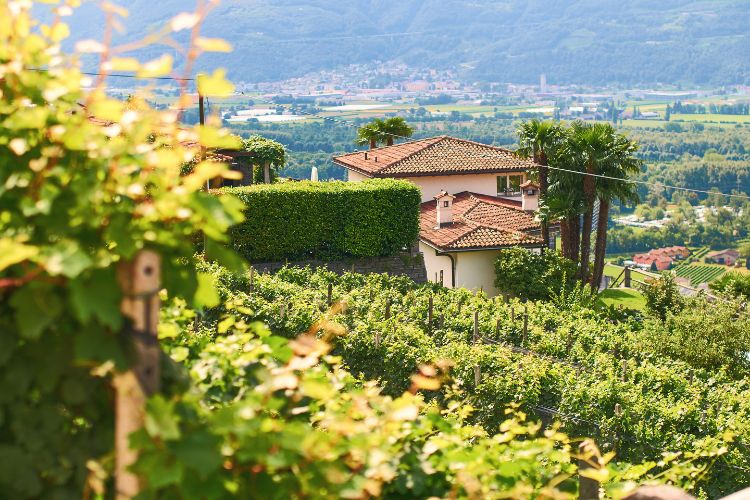
Adding to the language diversity of Switzerland, Ticino is primarily an Italian-speaking canton and actually resides just north of Milan.
Another region that has been producing wine since the time of the ancient Romans, Ticino is actually a relatively new quality wine region within Switzerland, thanks in large part due to the introduction of the Merlot grape variety from France in the early 1900s.
Located in Southern Switzerland, Ticino offers calcareous type soil that is ideal for wine production and temperatures that encourage optimal ripening at the appropriate altitudes. While Merlot is traditionally adapted to both cool and warm climate conditions, cooling during blooming can inhibit ultimate ripening, so production must be monitored closely and vintage can play a significant part in quality for any given year.
Valais
Characterized largely as the origination of the Rhône River, which runs south into France from the Swiss Alps, Valais is seen as being both one of the wettest and driest wine growing regions within the southwestern corner of Switzerland.
It’s really not known for wine production among consumers, though industry professionals are no doubt aware of its production quality. If anything, travelers tend to visit Valais to see the Matterhorn Peak and ski the region from famed resorts such as those in Zermatt.
RECOMMENDED: Wine Included – Check Out These Luxury Ski Resorts in Zermatt
While the skiing and snowboarding in Valais offers enthusiasts something truly special, it’s during the summer and fall months that visitors can stumble upon vineyards at elevation producing gorgeous Chasselas and Petite Arvine. Amigne, Sylvaner, Humagne Blanche, Humagne Rouge, and Pinot Gris are also of noteworthy quality and are produced within Valais.
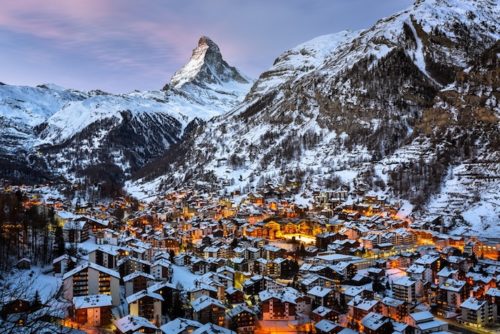
But it’s not just dry red and white wine you can find in Valais. Sherry style wine, called Vin de Glacier is crafted with the Swiss wine grape variety Reze, using a Spanish solera style of production (fermented grape juice of different ages are blended, with older liquid then being drained and bottled with new juice being added). Not only is this style of production labor-intensive, these wines are also aged at extreme elevation which helps to provide the best climate for maturation in this style, hence, the epic name, Vin de Glacier.
Vaud
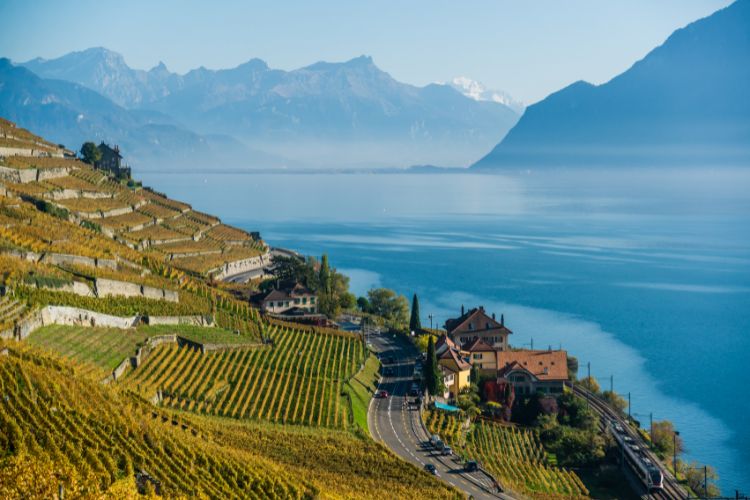
The most noteworthy of the 6 wine-growing appellations within Vaud is no doubt Lavaux. It’s also the largest, spanning over 800 hectares. It’s here that wine production has flourished for centuries stemming from grapevines that line the northern shoreline of Lake Geneva for roughly 30 kilometers. These terraced vineyards stack in some cases as high as 40 on slopes that stretch as high as 1,100 feet up. This makes them some of the steepest terraced vineyard sites in the world. Not only is the beauty of this region truly special, vine positioning also has many practical benefits. Some of these benefits include natural and consistent heating and climate control, derived primarily from the sun itself but also from the reflection of the lake and the stone walls and soil composition within which vine roots work to crank out grapes of complexity. Lavaux is so unique and beautiful that it’s been under protection by UNESCO since 2007.
The other wine regions of Vaud include Aigle, Chablais, Dézaley, La Côte, and Yvorne.
Zürich
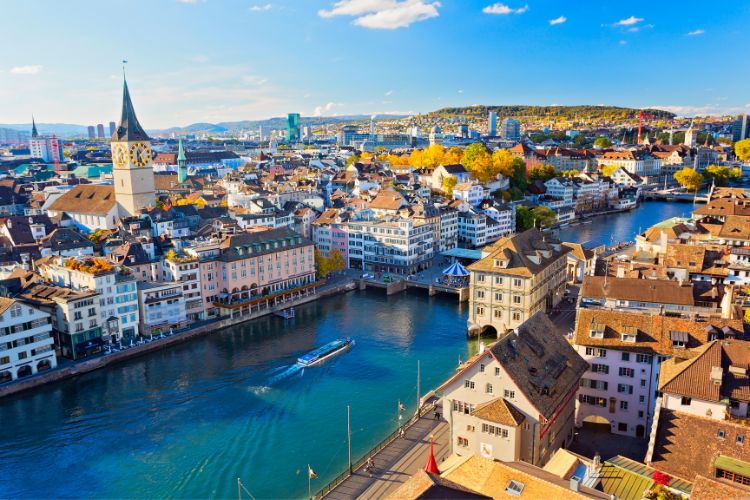
As the heart of German-speaking Switzerland, Zürich boasts a rich viticulture legacy, the largest of its kind in the region. The wine production is spread across gently rolling hills and slopes that flank the beautiful Lake Zürich. While the region is fairly urbanized, vineyards dot the landscape and contribute significantly to its pastoral beauty.
Zürich is renowned for producing diverse varietals, though the spotlight shines brightest on Müller-Thurgau, also known as Riesling-Sylvaner, and Pinot Noir. The local specialty, Räuschling, a light and crisp white wine with refreshing acidity, is another feather in Zürich’s viticulture cap. Its uniqueness is attributed to the region’s limestone soils and temperate climate, bringing forth the wine’s subtle citrus and floral notes.
Aargau
Nestled between the Jura mountains and the Black Forest, Aargau finds its strength in its remarkable versatility. The region is famed for its diverse range of both red and white wines, with Riesling-Sylvaner, Pinot Noir, and Merlot among its most prominent varieties. The unique soils, consisting of a mix of clay, limestone, and marl, along with the region’s temperate climate, work in harmony to nurture grapes that bring forth wines of distinct character and finesse.
Basel-Landschaft and Basel-Stadt
In the cross-border region of Basel, a deep-rooted wine tradition dating back to Roman times thrives to this day. The local vineyards, nestled between the Rhine river and the gentle Jura slopes, create a distinct microclimate conducive to growing premium quality grapes. The region, with its sandy loam soils, predominantly cultivates Pinot Noir and Müller-Thurgau, yielding wines that resonate with a mineral richness and vibrant fruity notes.
Thurgau
Thurgau, the ‘apple canton’, bears a viticulture identity that goes beyond its famous orchards. This region is especially significant for its production of Müller-Thurgau, a grape named partly after the canton. Thurgau wines are characterized by their aromatic intensity, echoing notes of apple and elderflower, with a bright acidity and balanced body, making them an excellent accompaniment for local Swiss cuisine.
Schaffhausen
As the northernmost wine region in Switzerland, Schaffhausen’s vineyards are graced by the moderating influences of the Rhine river. The region is best known for its Blauburgunder. These wines express an elegance and earthy depth that are typical of cooler climate Pinot Noirs, presenting lush red fruit notes underlined by a distinctive mineral streak.
Fribourg
Tucked away in the western part of Switzerland, Fribourg is a less-known gem in the Swiss wine map. Especially around Vully, the vineyards overlook Lake Murten, offering a picture-perfect view of vineyards stretching down to the water. The region produces mainly Chasselas and Pinot Noir. The local wines express an intriguing combination of freshness and structure, with a generous fruit-forward profile.
Valle d’Aosta (Almost Swiss)
Despite being officially in Italy, Valle d’Aosta shares a cultural and geographical affinity with Switzerland. At the foot of the Alps, this region crafts wines that are an embodiment of the mountainous terroir. Though diverse in styles and varieties, the indigenous Fumin, Petite Arvine, and Mayolet grapes are noteworthy for producing wines with alpine freshness, intriguing minerality, and a fruit-driven palate.
Frequently Asked Questions about Swiss Wine & Swiss Wine Regions
You are reading “Switzerland Wines & Wine Region Guide” Back To Top
Swiss wine, grape varieties of Switzerland, Switzerland wine styles: Most Picturesque Wine Regions
If you enjoyed this guide, make sure you register to become a Winetraveler for free! You’ll get access to all of our content and interact with other Winetravelers and for travel inspiration around the world. Be sure to follow along with us on Twitter and Instagram as we continue to feature more exciting destinations.
